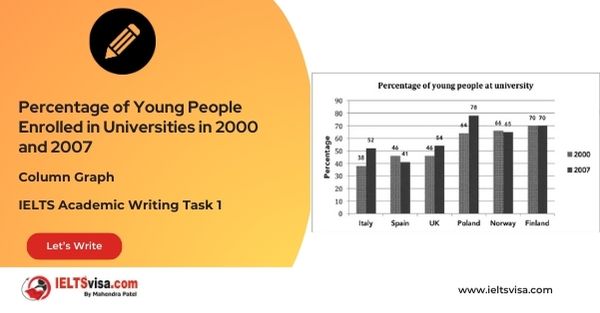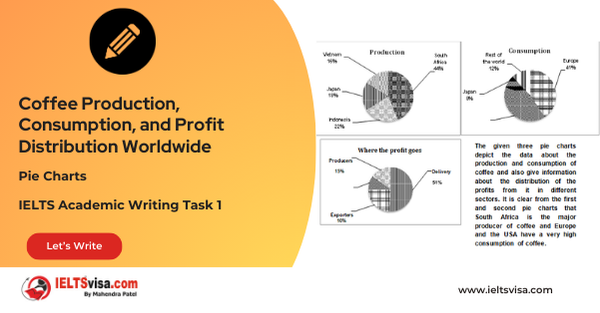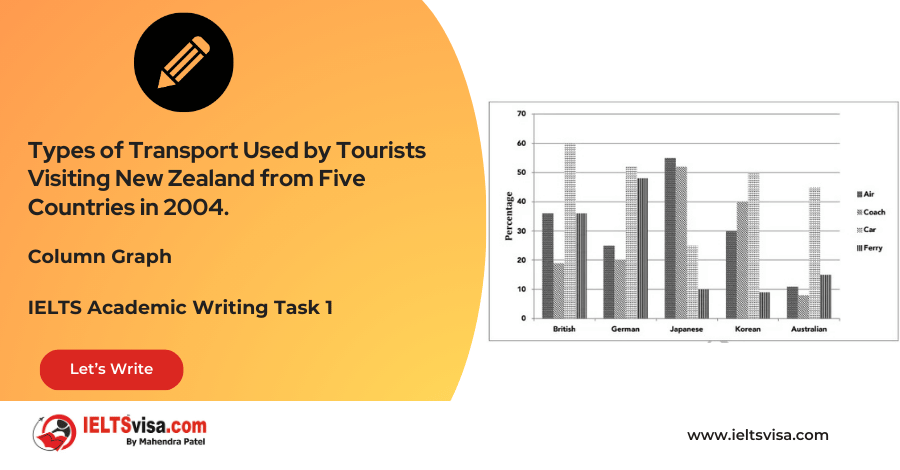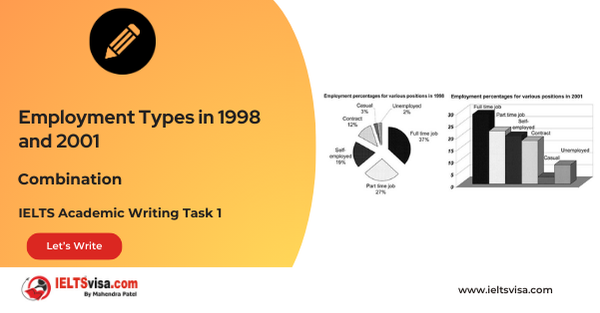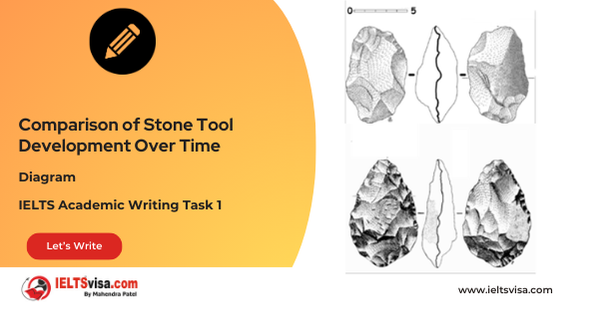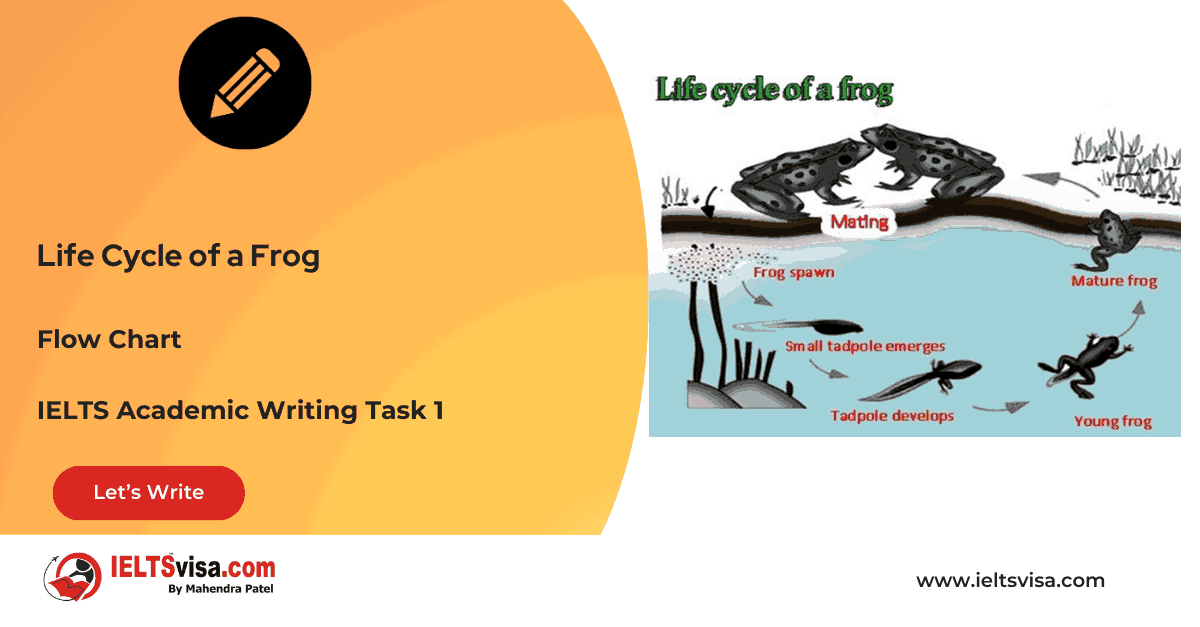Annual Teaching Hours by Teachers in Different Countries (2001)
IELTS Academic Writing Task 1 - Bar Graph
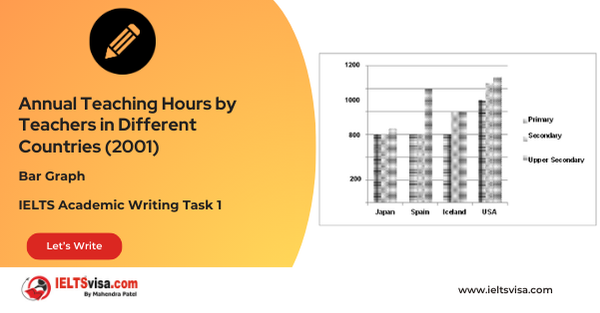
IELTS Writing Task 1 Question
The chart below shows the hours of teaching per year done by each teacher in four different countries in 2001. Summarise the information by selecting and reporting the main features and make comparisons where relevant.
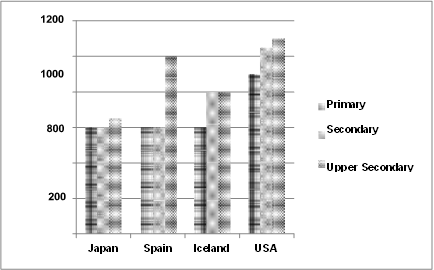
Common Questions for Teacher Hours Chart
1. Graph Type: Column graph.
2. Title: Annual Teaching Hours by Teachers in Different Countries (2001).
3. What are the units of measurement?: Number of hours.
4. Who: Teachers in four countries (Japan, Spain, Iceland, USA).
5. When: Year 2001.
6. Where: Japan, Spain, Iceland, USA.
7. Topic: The chart compares the annual teaching hours for primary, secondary, and upper secondary teachers in four countries.
Comparison Showing and Trends
Comparison 1: Teaching Hours by Country
- Teachers in the USA taught the most hours across all levels, with 900 hours for primary, 1050 hours for secondary, and 1100 hours for upper secondary students.
Comparison 2: Teaching Hours by Country (Primary and Secondary)
- Japanese and Spanish teachers both taught 600 hours annually for primary and secondary classes. The USA teachers taught more, with 900 hours for primary and 1050 hours for secondary students.
Comparison 3: Teaching Hours by Country (Upper Secondary)
- Spanish teachers taught the most hours at the upper secondary level, with 1000 hours, compared to the 650 hours taught by Japanese teachers.
Sample Answer
The given column graph compares the number of teaching hours per year in primary, secondary, and upper secondary classes by teachers in Japan, Spain, Iceland, and the USA in 2001. It is clear from the graph that teachers in the USA taught the most hours across all three levels.
In Japan and Spain, teachers taught 600 hours annually in primary and secondary education. However, Spanish teachers taught 1000 hours at the upper secondary level, significantly more than the 650 hours taught by Japanese teachers. Icelandic teachers, on the other hand, taught 600 hours at the primary level and 800 hours at both secondary and upper secondary levels. In contrast, teachers in the USA taught 900 hours for primary classes, 1050 hours for secondary classes, and 1100 hours for upper secondary classes.
Overall, it is evident that primary and secondary education received fewer teaching hours compared to upper secondary education in all the countries, with the USA having the highest teaching hours across all categories.
Top 25 Vocabulary
Vocabulary |
Meaning |
Synonyms |
Examples |
Type |
|---|---|---|---|---|
| Comparison | The act of examining similarities or differences | Contrast, juxtaposition | “The comparison of teaching hours shows the USA as having the highest numbers.” | Noun |
| Measure | The action of determining the size, amount, or degree of something | Gauge, estimate | “The number of hours is a key measure of teaching workload in these countries.” | Noun/Verb |
| Allocate | To distribute or assign something for a particular purpose | Distribute, assign | “Teachers in each country are allocated a different number of teaching hours.” | Verb |
| Education | The system or process of teaching and learning | Schooling, instruction | “The education system in each country dictates the number of teaching hours.” | Noun |
| Level | A specific stage or rank within a hierarchy | Rank, tier | “Teachers at the upper secondary level taught the most hours in all countries.” | Noun |
| Trend | A general direction or pattern of change | Pattern, movement | “The trend shows an increase in teaching hours as the educational level advances.” | Noun |
| Variation | The difference or deviation in something | Difference, disparity | “There was a noticeable variation in teaching hours across the countries.” | Noun |
| Diverge | To separate or go in different directions | Differ, split | “Teaching hours in Japan and Spain diverged at the upper secondary level.” | Verb |
| Approximate | Close to but not exactly the same as something | Rough, near | “The approximate number of teaching hours in primary education is 600 hours.” | Adjective/Verb |
| Increase | To become greater in size, number, or degree | Rise, growth | “There was an increase in the number of teaching hours at the upper secondary level.” | Noun/Verb |
| Decline | A gradual decrease in number, quality, or value | Decrease, reduction | “There was a slight decline in teaching hours at the primary level.” | Noun/Verb |
| Allocate | To set aside for a specific purpose | Assign, designate | “The hours allocated for upper secondary education were the highest.” | Verb |
| Examine | To inspect or analyze something carefully | Study, inspect | “We will examine the number of teaching hours across various countries.” | Verb |
| Average | The typical amount or mean | Median, norm | “The average number of teaching hours in the USA was higher than in other countries.” | Noun/Adjective |
| Overall | Considering everything as a whole | All in all, generally | “Overall, the USA had the highest teaching hours across all levels.” | Adjective/Adverb |
| Impact | The strong effect or influence of something | Effect, influence | “The impact of longer teaching hours was evident in the USA.” | Noun |
| Subsequent | Occurring or coming after something | Following, succeeding | “Subsequent years showed increases in teaching hours in some countries.” | Adjective |
| Revealed | To make known or disclose something | Exposed, disclosed | “The data revealed that Japan and Spain had similar teaching hours in 2001.” | Verb |
| Evident | Clearly visible or understood | Obvious, apparent | “It is evident that upper secondary education received more teaching hours.” | Adjective |
| Increased | To become larger or more in number or degree | Expanded, augmented | “The number of teaching hours in the USA increased significantly by 2007.” | Adjective/Verb |
| Annual | Occurring once a year | Yearly, per annum | “Teachers in the USA taught more hours annually than those in other countries.” | Adjective |
| Devoted | To give time or effort to something | Dedicated, allocated | “Icelandic teachers devoted 800 hours to teaching secondary and upper secondary classes.” | Verb |
| Secondary | Relating to education after primary school | High school, intermediate | “Spanish teachers taught 1000 hours to upper secondary students.” | Adjective |
| Upper secondary | Referring to the highest level of secondary education | Senior school | “Upper secondary teachers in the USA taught the most hours.” | Adjective |
| Significant | Sizable, important | Considerable, notable | “Spanish teachers taught a significantly higher number of hours in upper secondary education than Japanese teachers.” | Adjective |

Our Books
Master IELTS Speaking Part 1
IELTS Writing Task 1 Book
IELTS Writing Task 2 Book
Writing Task 1 Question Types
Practice IELTS Other Modules
IELTS Listening
The IELTS Listening test assesses how well you can understand spoken English in various contexts. It lasts about 30 minutes and is divided into four sections with a total of 40 questions. The listening tasks become increasingly difficult as the test progresses.
IELTS Academic Reading
The IELTS Academic Reading section assesses your ability to understand and interpret a variety of texts in academic settings. It is designed to evaluate a range of reading skills, including skimming for gist, reading for main ideas, reading for detail, understanding inferences, and recognizing a writer's opinions and arguments.
IELTS Speaking
The IELTS Speaking test assesses your ability to communicate in English on everyday topics. It lasts 11-14 minutes and consists of three parts: introduction, cue card, and a discussion based on the cue card topic.
IELTS General Reading
IELTS General Reading tests your ability to understand and interpret various types of texts. Here are some key areas and types of content you can expect to encounter in the reading section, along with tips for effective preparation.
IELTS Academic Writing Task 1
In IELTS Academic Writing Task 1, you are presented with a visual representation of information, such as graphs, charts, tables, or diagrams, and you are required to summarize, compare, or explain the data in your own words.
IELTS General Writing Task 1
In IELTS General Writing Task 1, you are required to write a letter based on a given situation. The letter can be formal, semi-formal, or informal, depending on the prompt. Here’s a breakdown of the key components to include in your letter
IELTS Academic Writing Task 2
In IELTS Academic Writing Task 2, you are required to write an essay in response to a question or topic. Here’s a guide to help you understand the essential elements of this task
IELTS Exam Tips
To succeed in the IELTS exam, practice regularly, familiarize yourself with the test format, improve your vocabulary, develop time management skills, and take mock tests to build confidence.
Grammer for IELTS
Grammar is the foundation of effective communication in English. Understanding tense usage, subject-verb agreement, and sentence structure enhances clarity and coherence in writing and speaking.
Vocabulary for IELTS
Vocabulary plays a crucial role in the IELTS (International English Language Testing System) exam, especially in the Speaking and Writing sections. Here’s an overview of why vocabulary is important and how it impacts your performance
RECENT IELTS SAMPLES QUESTIONS AND ANSWERS
Task 1 – Column graph – Percentage of Young People Enrolled in Universities in 2000 and 2007.
20:00 Start Pause Stop [df_adh_heading title_infix="IELTS Writing Task 1 Question" use_divider="on"...
Task 1 – Pie Charts – Coffee Production, Consumption, and Profit Distribution Worldwide
20:00 Start Pause Stop [df_adh_heading title_infix="IELTS Writing Task 1 Question" use_divider="on"...
Task 1 – Column graph – Types of Transport Used by Tourists Visiting New Zealand from Five Countries in 2004.
20:00 Start Pause Stop [df_adh_heading title_infix="IELTS Writing Task 1 Question" use_divider="on"...
Task 1 – Bar and Pie Chart Combination – Employment Types in 1998 and 2001
20:00 Start Pause Stop [df_adh_heading title_infix="IELTS Writing Task 1 Question" use_divider="on"...
Task 1 – Diagram – Comparison of Stone Tool Development Over Time
20:00 Start Pause Stop [df_adh_heading title_infix="IELTS Writing Task 1 Question" use_divider="on"...
Task 1 – Flow chart – Life Cycle of a Frog
20:00 Start Pause Stop [df_adh_heading title_infix="IELTS Writing Task 1 Question" use_divider="on"...

